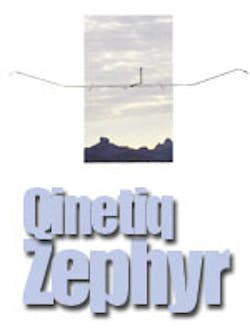Qinetiq Zephyr in the air for over 2 weeks
Qinetiq Zephyr being prepared for take off
This is an older Zephyr in flight
Qinetiq's latest Zephyr UAV broke world records by flying on its own for 2 weeks and 21 minutes. The flight took place at the US Army's Yuma Proving Ground in Arizona. The solar powered high-altitude long-endurance (HALE) Unmanned Air System (UAS) set a new record when it beat the official world record of 30 hours 24 minutes set by Northrop Grumman's RQ-4A Global Hawk on 22 March 2001.The Federation Aeronautique Internationale (FAI), the world air sports federation, monitored the flight.
"Zephyr is the world's first and only truly persistent aeroplane,” said Neville Salkeld, MD of QinetiQ’s UK Technology Solutions Group. "We are really proud of the team’s achievement which has been supported by expertise from across the QinetiQ business and beyond. We’ve now proved that this amazing aircraft is capable of providing a cost effective, persistent surveillance and communications capability measured in terms of weeks, if not months. Not only is Zephyr game-changing technology, it is also significantly more cost effective to manufacture and deploy than traditional aircraft and satellites."
Chris Kelleher, QinetiQ’s chief designer said: “We have designed, built and delivered what will be remembered as a milestone in aviation history. Zephyr will transform the delivery of current services such as communications, and lead to many new applications which are not possible or affordable by other means.
"The brand-new ‘production ready’ Zephyr airframe incorporates totally new approaches to aerodynamics, structures, propulsion, avionics, flight controls, power system management, thermal control, ground control station design and payload, as well as overall operating processes. Our outstanding team has brought this entire 'one-shot' flight together at the first time of asking, demonstrating we can operate both the aircraft and its ultra-light utility payload routinely for long duration flights.
“We’ve also had to design for temperatures of around plus 40ºC on the ground to below minus 75ºC at altitude, ever changing weather systems including storms and high winds – and Zephyr took them all in its stride. It is a truly fantastic achievement.”
The Zephyer has a winspan of 22.5m. The wings are covered with thin, amorphous silicon solar arrays from Uni-Solar. The solar array charged the on-board lithium-sulphur batteries from Sion Power Inc. The 50Kg Zephyr is built using an ultra-lightweight carbon-fiber design.
About the Author
William G. Wong
Senior Content Director - Electronic Design and Microwaves & RF
I am Editor of Electronic Design focusing on embedded, software, and systems. As Senior Content Director, I also manage Microwaves & RF and I work with a great team of editors to provide engineers, programmers, developers and technical managers with interesting and useful articles and videos on a regular basis. Check out our free newsletters to see the latest content.
You can send press releases for new products for possible coverage on the website. I am also interested in receiving contributed articles for publishing on our website. Use our template and send to me along with a signed release form.
Check out my blog, AltEmbedded on Electronic Design, as well as his latest articles on this site that are listed below.
You can visit my social media via these links:
- AltEmbedded on Electronic Design
- Bill Wong on Facebook
- @AltEmbedded on Twitter
- Bill Wong on LinkedIn
I earned a Bachelor of Electrical Engineering at the Georgia Institute of Technology and a Masters in Computer Science from Rutgers University. I still do a bit of programming using everything from C and C++ to Rust and Ada/SPARK. I do a bit of PHP programming for Drupal websites. I have posted a few Drupal modules.
I still get a hand on software and electronic hardware. Some of this can be found on our Kit Close-Up video series. You can also see me on many of our TechXchange Talk videos. I am interested in a range of projects from robotics to artificial intelligence.

